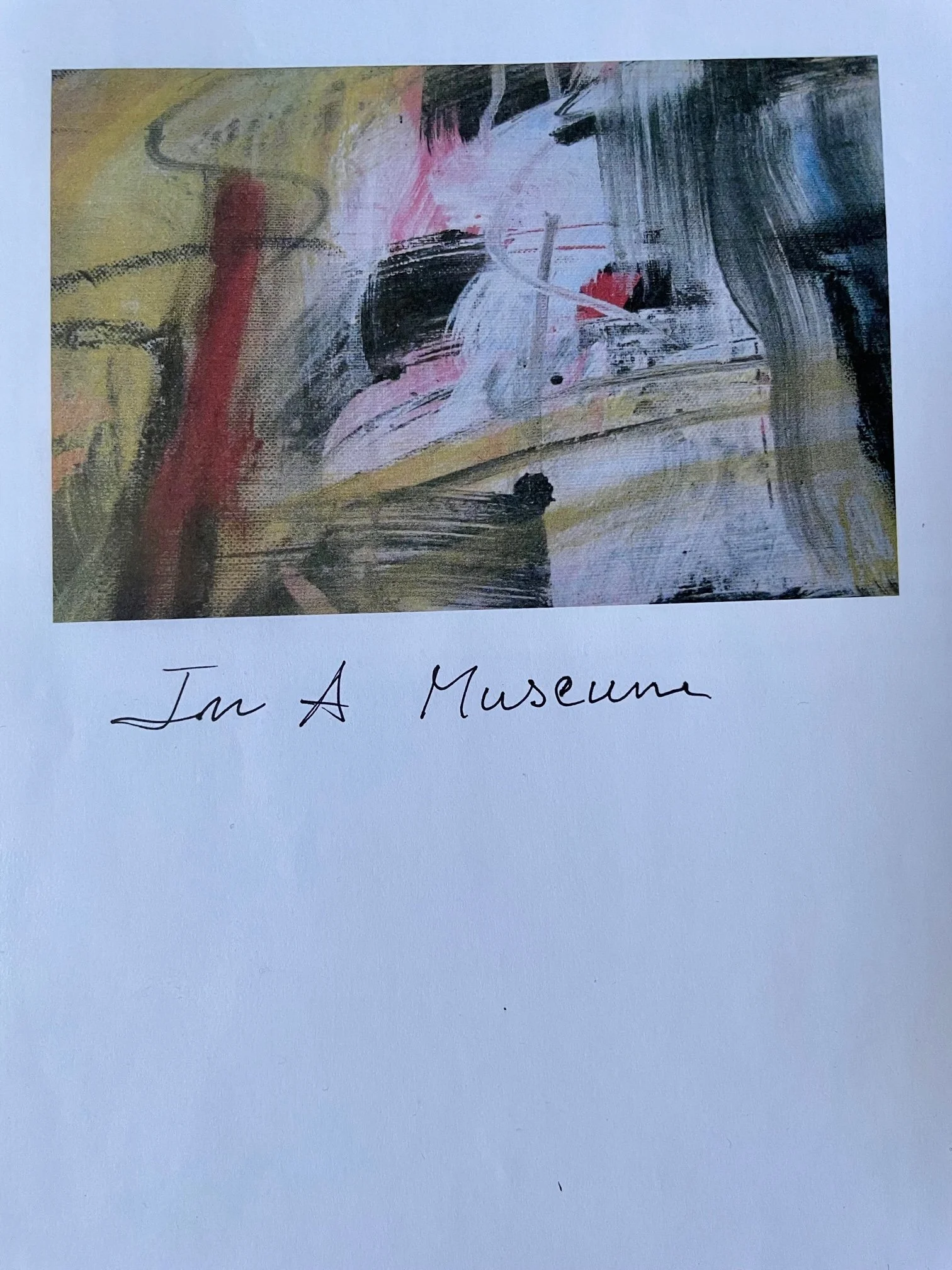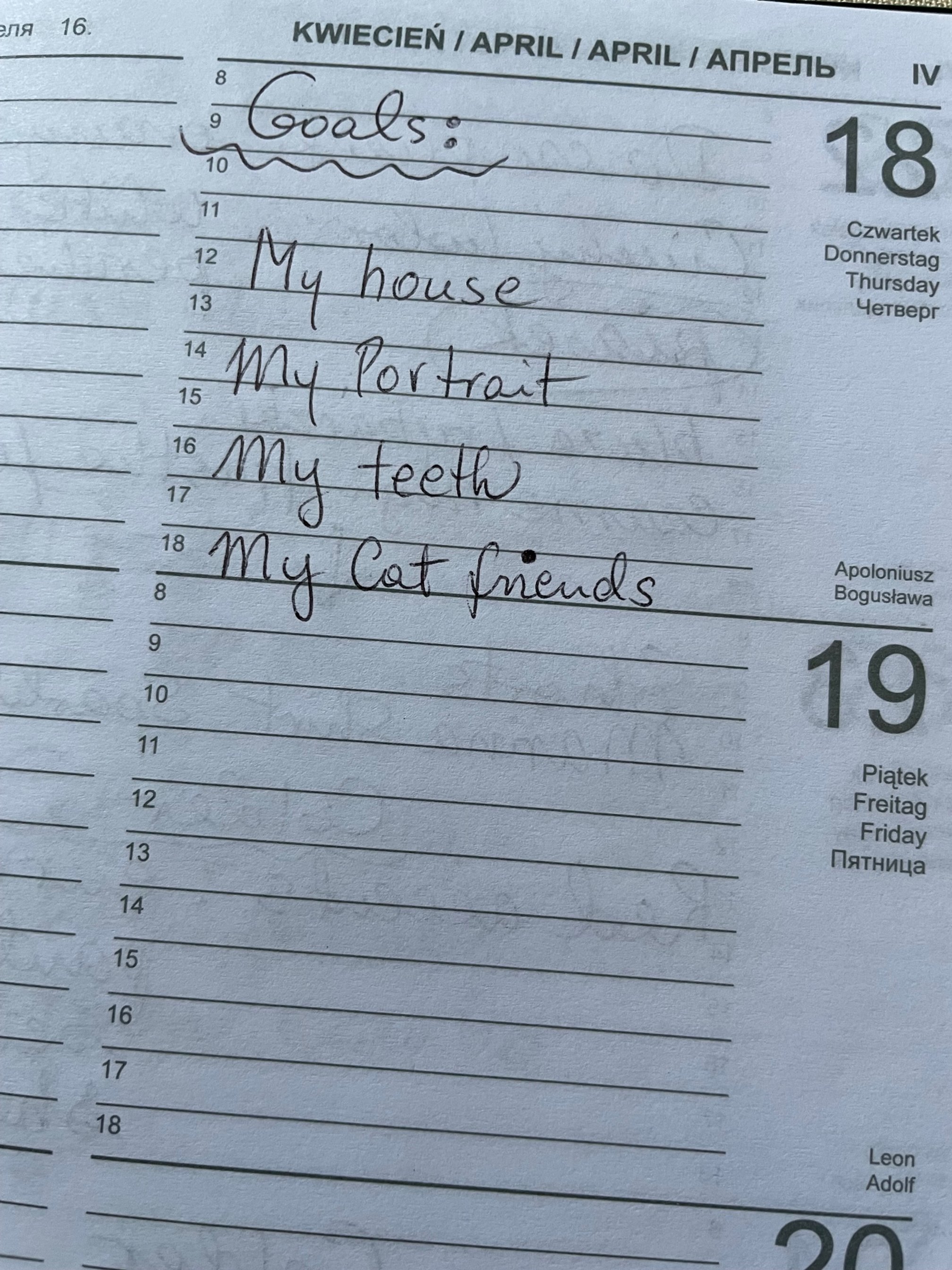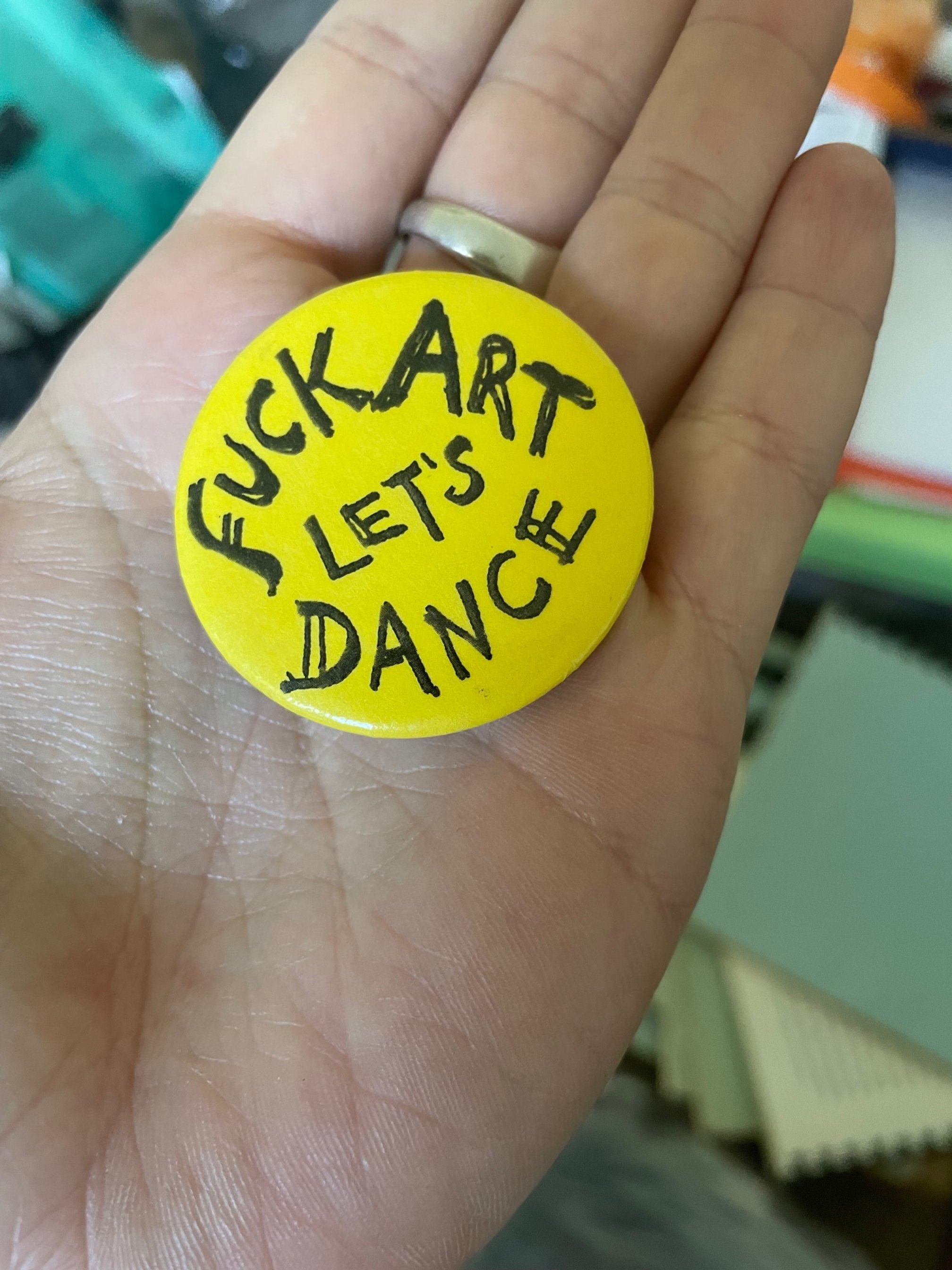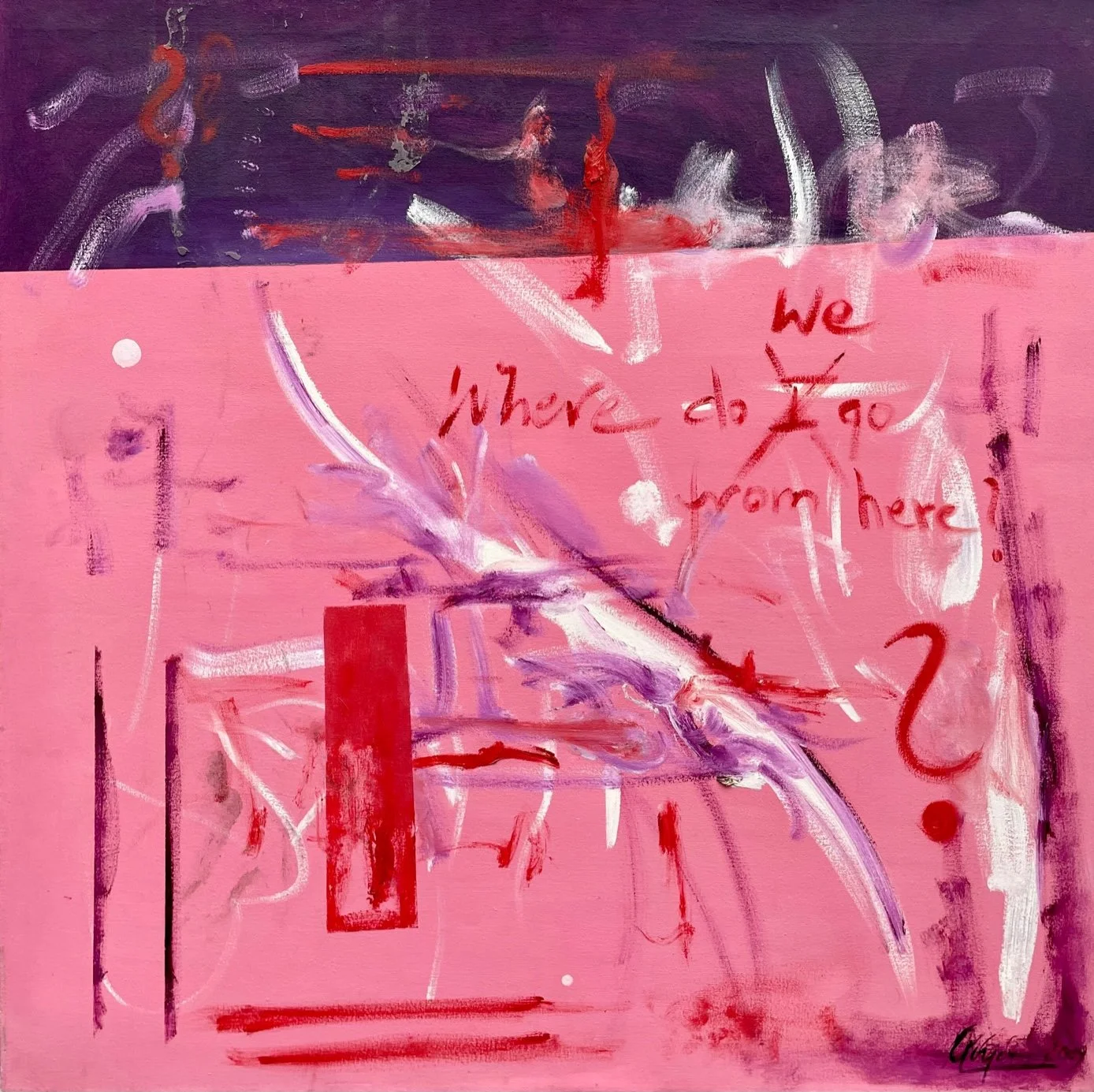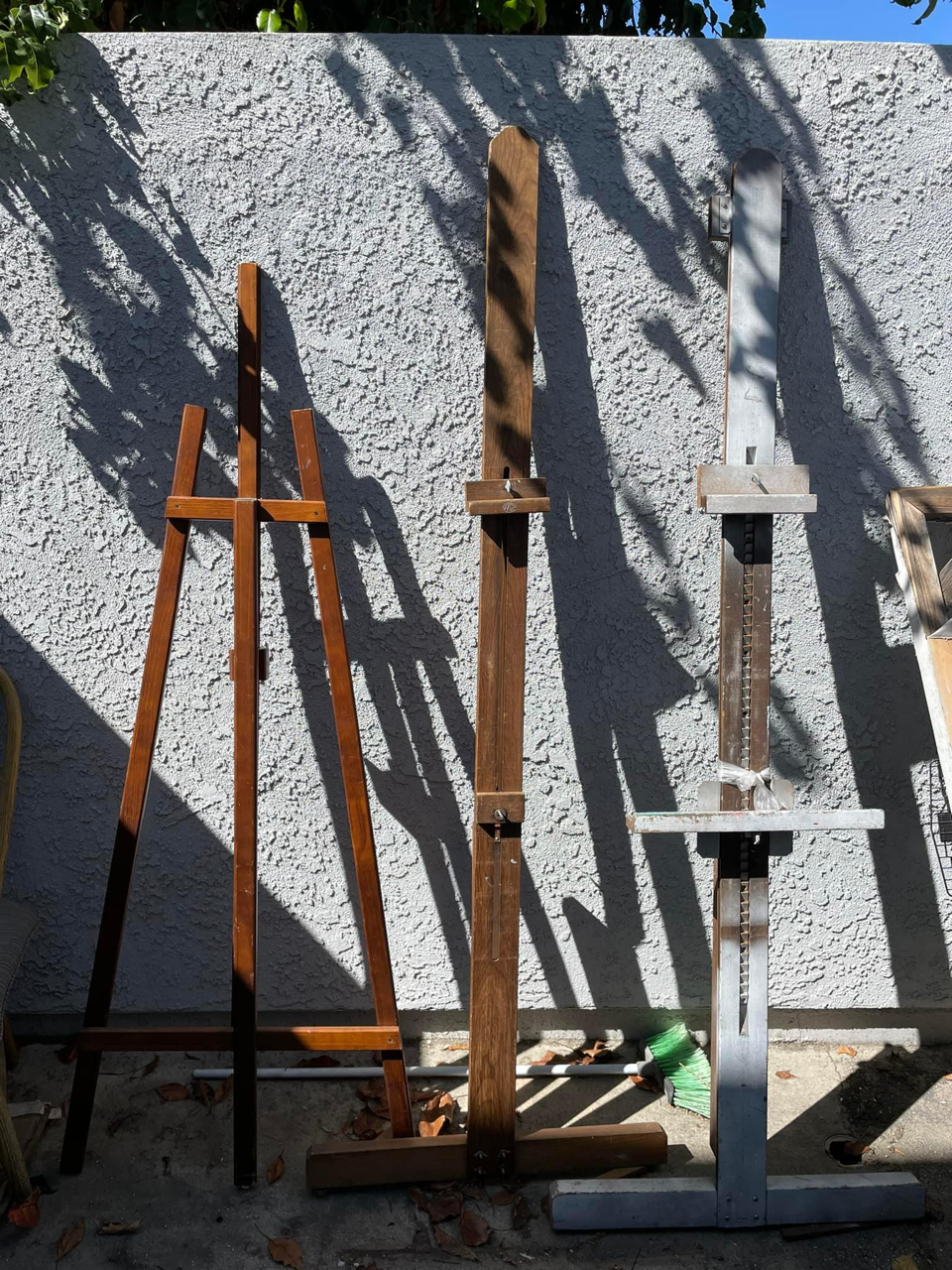Art is in you
Time to go now.
Every drawer, every closet cleared. Every photo, every piece of writing packed. The clothing donated. The car sold. The cats re-homed. The furniture.
Beside bins of memories and dreams, beside a life’s worth of paintings now in stacks against the wall, on the floor now, I sleep. Soon this will all be behind me, in the back of a cargo van across two days and two States of driving. To a storage unit where temporarily it will go. Temporarily, I say, because the plan, my dream now, is to find these works light and space. An exhibit. I just have to work out the making of this dream, but I’ll try. For Mom, maybe for me. A second life.
I see my life as some strange happening, a life as itself — an art form. Because journey has a meaning on its own. The significance of creating or searching is not only in the final product.
— This, found on a scrap of paper here during the clearing.
~
What could the exhibit be? The story of this journey, from faraway to L.A. The story of a woman working for her freedoms always, for survival, for her self. Through the rented rooms and the different jobs to make a living while always writing and creating when the sun goes down, as she penned in a letter to the L.A. Opera (also just found).
A study in process. Of the search for style, for technique, through the many fragments en route to the simple lines and simple air, which she found in the end. There could be Liberty across one wall, those giant graffiti-style canvases inspired by our trip New York, and seeing that torch up in the fog. And pastels and poetry on another wall, inspired by L.A. and her beloved palms.
Of course there would be some of the prose, and her pets.
And just think: the museum goer could arrive and be greeted like this, with her humor, right at the door:
In a museum there are no longer paintings
Only large-breasted women with perfectly crafted nails
On the other side — good-looking men with headphones
I didn’t fit in, so through the Red Neon Light exit — I left
Then, perhaps through a neon entrance, one could take in Mom’s journey as I’ve attempted to lay out here in these writings. Maybe the best thing I’ve heard during these painful days, said by a few, is “I really feel like I know her,” even if they didn’t. This was always the point. And would continue to be.
Of course I’m biased. I’m the grieving son trying to keep his mom’s voice here. But I do feel like what she taught me and always hoped to show others could be shared, passed on a little further. She gave me life, but also this way of looking. At this world. A tree. Our cloud.
At how everything is a composition, a mystery, a riddle.
~
The lasting image of Mom, the one most firmly pressed to mind, will always be this, from childhood: Mom there somewhere, between calls or making meals, between jobs or our baseball games or our bedtime — Mom there somewhere, standing before an easel, with paint on her clothes and fingers (I loved this), and stepping back from a canvas and the dipping water and that stretch of cardboard with swirls of color there, and curling two fingers over her eye to make a keyhole, and squinting through it. Trying to see just the painting there, nothing else. Not me, there watching. Not the chaos of what’s around. Not my dad, not the dishes, or the lack of dollars, or the memories of Poland. Not the regrets or hassles of every day, no, just the work there: is it something? Is it her? Is it finished? Or does some area need some bit of further color, shape, or touch?
She taught me then, and still now, how we can always make these little keyholes with our fingers and minds and try to unlock something. We can always go somewhere else, or inside, into colors and space and light of our own making, and look. Is it something?
This way of looking, of being, she always wanted to share. In The Great Clearing here I’ve found copies of letters sent to schools or art centers, pitching workshops or classes: Art History as an Inspiration for Art Practice, she wrote, which would aim to encourage creativity with the use of knowledge of artistic experiments in the past.
Or an art therapy program for special education students, emphasizing awakening self-awareness in students by encouraging the process of making decisions according to individual, specific needs. …
She wrote there:
How does it work in practice? Every student has a different personality, so at first I try to talk to him or her, trying to reveal what they like to do, what are their specific interests, etc. Then I ask my students to write a few sentences about themselves. Usually I don’t expect a lot of information, if any, from this, but I observe particular writing techniques. A student may not be able to draw lines that are curvy or may be writing and erasing each word repeatedly over and over again. This gives me a lead to what kind of technique in art I should recommend. For the student with the “curvy line” problem, drawing horses is thought to be a good start as an example of “drawing objects with the use of circles” technique. For a “compulsive eraser” person the pastel technique may be helpful with its smearing, transparent effects. …
Making choices through art. … Learning about dealing with tensions through art (although it creates stress, in the case of art the student is motivated by the aesthetic goal, which makes him more agreeable to cope with such tensions). … Metamorphosis in art … Learning how to be self critical and analytical through art …
~
An exhibit could include also her life’s worth of little notes, like this one:
Goals:
My house
My Portrait
My teeth
My Cat friends
Or this one :
If you no longer / Had a place to stay / If everything of comfort / Went away / You would not miss / The flight to the Bahamas / All you would miss / Is your flannel pajamas / Your plate with breakfast / Your coffee, your bathroom robe / Your bed, your toe / And by your feet — your dog / All you would miss is / What now you have
Things you don’t notice
Or this:
and for one reason: I was a human being. and I wanted to feel like one.
~
And of course this, the button I found finally, which inspired her poem, which inspired that post, the last writing I was ever able to read for her, when her breathing shallowed, when she turned to her side for the last time, when she was close.
~
And this:
Practically each one of us is a “creative artist” in a particular field. There are still many things we do not know about ourselves. This will help us to come to know ourselves and to understand the existence of the incomprehensible and unelucidated phenomenon of art — and of life. It will help us to experience the world in a creative, artistic manner. Perhaps it will change our perception of things. Art is a necessary inspiration for literally everyone, regardless of age, profession or intellectual level.
This, an excerpt from from the blue, bound book I found in the closet of the other room, where Swifty slept. Art is in You, it’s called, and inside Mom speaks of the riddle — a word she uses repeatedly there to describe this mystery of life, of art.
This book for me is a riddle also; I’ll never know how she had the time to put such ideas down in such an eloquent way back in 1982, when I was 1 and my brother 4, and my dad either away on one of his long Merchant Marine trips, or home and demanding as he was. For awhile I couldn’t put a finger on how the language was so intellectual, more than her English would have then allowed as she was still so new to the country. But when my finger found a copy with some edit markings, I realized from the handwriting that it must have been our next-door neighbor, Bill — who would become like a grandfather to myself and brother — who helped. He must have been the one to help put Mom’s thoughts down into these nicely typewritten, bound pages. Bill worked in an office for an oil company, was not an artist but extremely intelligent, and kind, and generous, and surely happy to take Mom’s thoughts and memories, which I recognize clearly here, and organize them into this long essay. On Page 1, it begins:
I became an artist partially by accident. Chance decides the fate of everyone — what they become, what vocation they choose. This is because our own interests often are not completely defined and we cannot fulfill them in one or more spheres of activity. And so it is that I am a painter. This does not mean that I am someone from another planet or that I live in another world. Many people regard an artist as either a “nut” or as a “genius” — at any rate, someone “different.” I do not believe this. An artist is an individual who specializes in a certain field, just as everyone else specializes in a profession. Most often an artist is one possessed with particular intuitition and imagination, which many non-artists likewise share. Many physicists, mathematicians, accountants and people in any number of occupations certainly could become artists. That they have not may well be that they never considered it.
~
How could the journey, such an exhibit end? Mom would surely wonder about this too, just as she did with “our book.” Or how in Art is in You she contemplates the problem of the “unfinished point,” saying there always exists this moment when an artist must choose to leave a work, or do more. And how in so many of the most fascinating artworks, such as Michelangelo’s unfinished sculptures, an element of incompleteness can yield great value by bringing the viewer in, into the process of making, of contemplating, of almost completing even.
Must an enigma be the complement of every perfect composition? Must death, a mystery, conclude our lives with which it creates its own specific composition? A perfect composition?
So maybe the visitor could take part, somehow, in this composition. Maybe he or she could add a brush stroke or idea to some collective, working canvas. Maybe an idea from Mom’s proposed workshop for that special education class could come into play:
The work of art can be redone or changed forever and its results can be seen immediately. My students will be encouraged to change and improve an art piece as many times as it is necessary to achieve an interesting and rich effect. Change adds more texture and variety, therefor it always improves its quality as an artwork. The student should realize that persistence always has positive final consequences.
~
Maybe Mom’s fragments of cut canvases could come into play — there’s a bin of them, bound for the move. Or her greeting cards — she collected an obscene amount of postcards and greeting cards, I’ve discovered also. They were just everywhere. And blank; it seems she bought them just in case, or when the mood or image or sentence there spoke to her. So now I’m left with hundreds and hundreds of postcards and greetings — from all sorts of places and for every occasion: Birthday, Christmas, Mother’s Day, and so on.
So why not add those to the composition, to the exhibit also. Maybe we could fan them out across a table along with her unused stamps, and put a little mailbox there, and the visitor could then choose a card of his liking, write a message or poem there, and either add to the shared space or send that fragment off to someone somewhere else.
Because art is also about connection. About closing these spaces between us.
Found in the final looking place, the final closet.
~
Art prompts reflection, abstract feeling not having anything in common with prosaic and stifling practicality and utility. When listening to music one does not ask, “What is this?” although for hours one can submit oneself to its mood. All forms of art should similarly affect man. All of the most important phenomena in life, such as birth and death, are not answers to the question, “What is this?” …
Our goal is to seek and not to find. … And everything tends towards this same thing — toward equilibrium and harmony. But it will never be achieved, since there is always an empty place which man perhaps never will be able to divine. What is this place, this constant desire for something we try through all fields to perceive? What is this constant source of energy for our activity? What is the complement, because there must be something of fulfillment?
Such is the law of the perfect composition. Perhaps this fulfillment is our faith in something we don’t know? Perhaps we perceive our riddle when we end our life, the life which at death creates a perfect and excellent composition. We always seek truth’s outer limit at the intersection of these two phenomena. One stroke of the brush does not say anything, but the second one already creates a dialogue and a mutual relationship, while the third, fourth and fifth create the whole story. When we, therefore, cross into the unknown and unseen we still add something to our composition and this means that we comprehend something more. For such is the law of creation.
We cross into the unknown with the interest of an artist, who is closer to and at the same time farther away from the riddle which is increasingly more explicit. We stand amid the chaos of our era increasingly wiser, lost, searching more intently but finding increasingly less. We build and we destroy simultaneously. Sometimes we reflect on the sense of all of this and sometimes we come to doubt the goals which we have set out for ourselves in life because they cannot be realized. We know that only one thing within us will not change — the constant and determined search for the unknown, because it alone is man’s sole calling. The goals we achieve are not so important because although they have been reached, this often leads nowhere or becomes a pitfall and a loss. But let us go forward because the instinct for exploration is the strongest one within us and nothing is able to restrain it.
We are increasingly closer and yet more distant from the riddle. Those of us who believe in their own perfection and absolute knowledge about the world deserve our sympathy. Those who feel their own inadequacies and strive to perfect themselves and the world are like the unfinished and yet perfect sculptures discussed earlier. Each sculpture is different, just as everything in life posesses its own individuality. Equally distinct is our own avenue of exploration. No artist paints a picture in the same way as someone else. Each path is completely different. For this reason when we enter a museum to marvel at its works of art we do not endeavor to encounter and understand them as others do. We do not ask the question, “What is this?” We simply try to perceive “What is this for me?” We trust our own feelings, which never will be completely like those of another human being. Let us seek our own way in all that surrounds us and we shall always make progress.
— Mom
